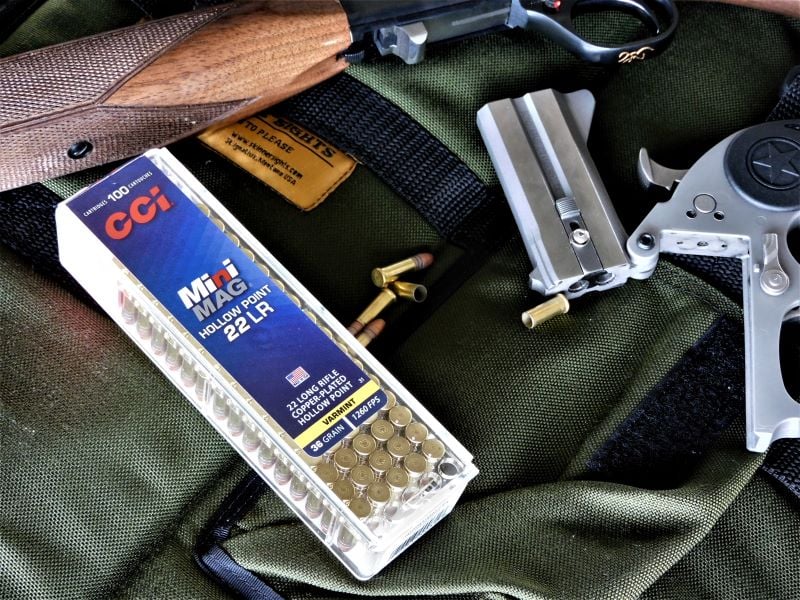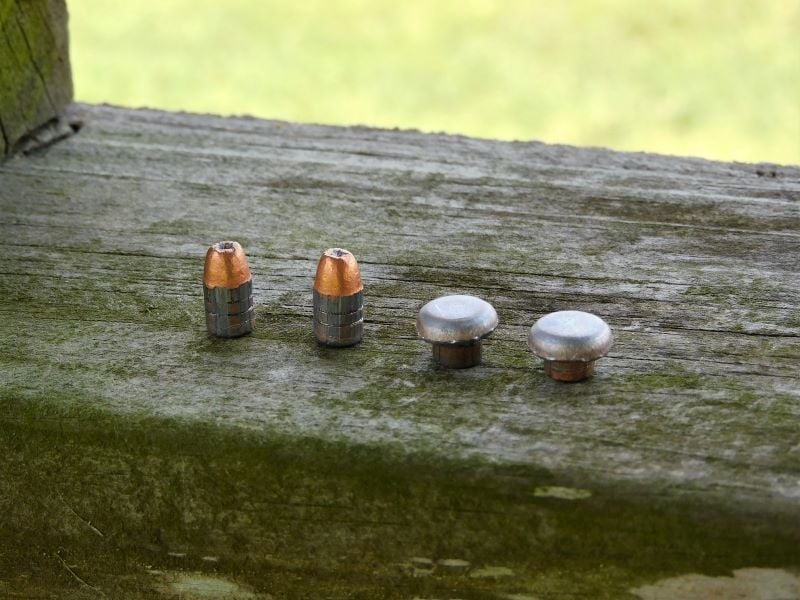If you own or want to own a firearm chambered in .22 Long Rifle, chances are that you know about the CCI Mini Mag. It is one of the most popular and reliable loads on the market today. Whether you are loading up for plinking, hunting, or personal protection, the CCI Mini Mag is a load worth testing.

Although high velocity .22 LR loads had been around since Remington introduced their HV load in 1930, .22 ammunition was, and is, notoriously unreliable. When it was introduced in 1963, the CCI Mini Mag was marketed as a powerful, yet reliable offering. It was offered in small lots and CCI put an emphasis on priming the cases to reduce the number of dud rounds.
Although CCI has gone on to produce a vast array of rimfire ammunition, the CCI Mini Mag is still the standard by which others are measured. But just how effective is it? I have shot game as large as coyote and printed some tight groups with the CCI Mini Mag, but I never gave the round a thorough rundown.

The CCI Mini Mag
On the surface, the CCI Mini Mag is little different from other rounds on the market today. The Mini Mag uses a copper-washed lead-heeled bullet housed in a brass rimfire case. It is a high-velocity loading with an advertised muzzle velocity of 1260 feet per second. Most ammunition from most manufacturers, whether you buy bulk pack boxes or small 50-round packets, are going to run you the same materials and the same nominal muzzle velocity when fired from a rifle.
The Mini Mag is also packed in 100-round trays and the rim of each round is well-primed from the factory. These trays tend to prevent the accumulation of moisture, unlike the piles of loose ammunition in large cardboard boxes. But far and away the singular feature of the Mini Mag is the priming. Rimfire ammunition is primed by packing the combustible compound into the crushable rim of each case. Sometimes, the priming breaks loose or is incompletely applied, resulting in dud rounds. CCI has a knack for durably priming their cases and a dud round with the Mini Mag is rare compared to other rounds on the market. The CCI Mini Mag is available in two different bullet choices: a 36-grain hollow-point and a 40-grain round-nosed solid. The 36-grain hollow-point is intended as a varmint load and it is the round I chose to evaluate.
Velocity Test
While the 36-grain CCI Mini Mag makes for a competent close-in varmint load when shot out of a rifle barrel, it may be a tempting option to stoke this warm hollow-point load in a concealed carry handgun. I decided to test the Mini Mag through two platforms: a Browning SA-22 rifle with a 19 3/8 inch barrel and a Bond Arms Stinger with a three-inch barrel. Both selections fit the rifle and short-barreled pocket pistol niche well and both will invite different results. But given the CCI Mini Mag, and most other 22 rounds, are built around rifle shooting, how much power is sacrificed when stepping down to a small handgun?
I started to answer that with a velocity test. I set up my Caldwell chronograph, benched both firearms from a distance of 10 feet, and fired a string of five rounds. The Browning came close to the advertised velocity with an average velocity of 1245 feet per second. The Bond Arms has a three-inch barrel, though one inch of that is taken up by the cartridge. Out of this short barrel, the CCI Mini Mag clocked in at 965 feet per second.
Despite this notable loss in velocity, the Mini Mag did not lose its consistency across both platforms. The extreme spread from the lowest velocity reading to the highest was only 30 feet per second with the Browning. The spread was only 38 feet per second with the pistol. As far as load consistency, the CCI Mini Mag tends to lack the underpowered and overpowered rounds that are often mixed into bulk ammo. The chronograph results confirm this. But with a loss of 280 feet per second when going from the rifle to the pistol, how will that affect the Mini Mag’s effect on target?
Gelatin Test
The velocity test showed the potential difference each round may have on target, given that hollow point ammunition is affected by how quickly the pills move from the barrel. Even solid non-expanding bullets can be robbed of penetrating power the shorter the barrel gets. Although a game necropsy would be the ultimate test of performance, I turned to ballistic gelatin to see how the CCI Mini Mag stacks comparatively when fired from both a pistol and a rifle.
From a distance of 10 feet, I fired two rounds from my Browning into two 10% Clear Ballistics gelatin blocks. To test a worst-case defensive scenario, I dressed the blocks with four layers of denim to simulate heavy clothing. I fired two rounds from the Bond at the same distance. One round landed too near the edge of the block and skipped out. But a third shot from the pistol landed squarely with the others.

In a previous test, we tested the CCI Velocitor 40 grain hypervelocity load from the same firearms in this same medium. The Velocitor has a higher velocity out of both the Browning and the Bond. I fully expected the old Mini Mag to underperform. Given that information, I was surprised that the Mini Mag held its own.
The Browning SA-22’s 19 3/8 inch barrel got those projectiles moving close to the advertised velocity. The two rounds fired produced a moderate amount of stretching damage that ran between 1.5 to 5 inches inside the first gelatin block. Both rounds kept on a fairly straight track and expanded before stopping right at eleven inches. The Velocitor load also mushroomed, but despite its velocity premium, penetrated to about the same depth.

The results with the Bond Arms Stinger also mirrored the findings in the Velocitor test. The two captured projectiles clogged their hollow-point cavities with denim. They scooted through the first block of gelatin with marginally less stretch damage than the rifle. Both rounds landed nose-first at the 10.5-inch mark.

The Takeaway
I have used CCI Mini Mag ammunition for years. I hunted with this hollow-point load on occasion with great success. But given how many exotic and more powerful .22 loads have come on the market since the Mini Mag debuted back in 1963, it is hard to get excited about the round. As such, I stuck with the round simply because it was a standard and I needed a round that would simply punch paper and go bang. For varmint work, the Mini Mag isn’t at the top of the heap. That is if you believe the advertised velocities printed on the box.
Advertised velocities and marketing claims promise a lot; but more often than not, the delivery is underwhelming and the price overwhelming. The Mini Mag isn’t hypervelocity or hypertouted. It is a simple, unpretentious round that deserves a look beyond punching paper and ventilating tin cans. If my little test is anything to go by, the Mini Mag delivers competent performance on par with the hot stuff without the added pocketbook premium.

